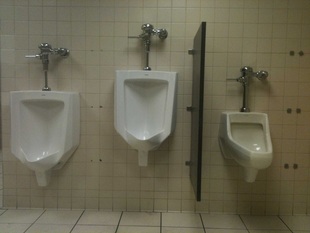
(image: unname restroom in Chicago)
Ultimately, every single person uses restrooms, either at home, at work, or in public settings. The ability to use a toilet, or urinal, to wash one’s hands or look in a mirror, to blow a nose, to change a baby or help someone use the restroom themselves, is a stunningly underrated and underappreciated practice. The past few years have seen the marked increase in personal mobile telephones and hydration devices, but not in public restroom access. It can also be argued that more people are now suffering from conditions causing frequent or urgent restroom use, such as diabetes or Chron’s disease, than ever before. Yet, the technology that has given us urinal video games and state-of-the-art hand dryers has not offered more accessible restrooms. Not that these improvements to restroom assets is negligible, as it does promote more talk and thought into restroom design, but emphasis needs to be placed on the nuts and bolts of restroom access.
The research methods and results offered by this study is an attempt to quantify the vague, discuss the uncomfortable, and include the excluded. It was an enjoyable yet difficult project, both personally and logistically. Primary data is always more difficult to acquire and analyze than second-hand data collected by others, which is what occurred far too often in similar studies and projects in the past. The role of the Geographer is to navigate across disciplines and tie together seemingly disparate subject matter to offer a unique and novel way of looking at the world around us. Hopefully, this study is only the beginning of a new way of examining public restroom access.
Ultimately, every single person uses restrooms, either at home, at work, or in public settings. The ability to use a toilet, or urinal, to wash one’s hands or look in a mirror, to blow a nose, to change a baby or help someone use the restroom themselves, is a stunningly underrated and underappreciated practice. The past few years have seen the marked increase in personal mobile telephones and hydration devices, but not in public restroom access. It can also be argued that more people are now suffering from conditions causing frequent or urgent restroom use, such as diabetes or Chron’s disease, than ever before. Yet, the technology that has given us urinal video games and state-of-the-art hand dryers has not offered more accessible restrooms. Not that these improvements to restroom assets is negligible, as it does promote more talk and thought into restroom design, but emphasis needs to be placed on the nuts and bolts of restroom access.
The research methods and results offered by this study is an attempt to quantify the vague, discuss the uncomfortable, and include the excluded. It was an enjoyable yet difficult project, both personally and logistically. Primary data is always more difficult to acquire and analyze than second-hand data collected by others, which is what occurred far too often in similar studies and projects in the past. The role of the Geographer is to navigate across disciplines and tie together seemingly disparate subject matter to offer a unique and novel way of looking at the world around us. Hopefully, this study is only the beginning of a new way of examining public restroom access.
 RSS Feed
RSS Feed